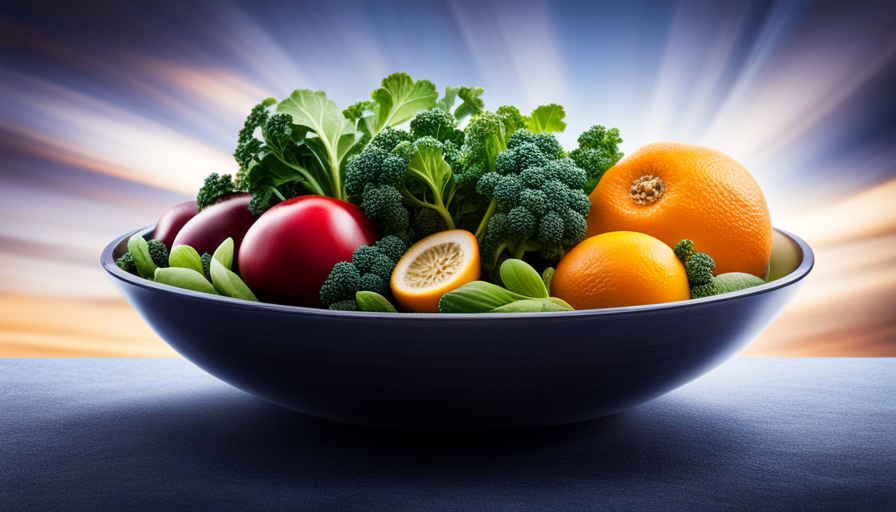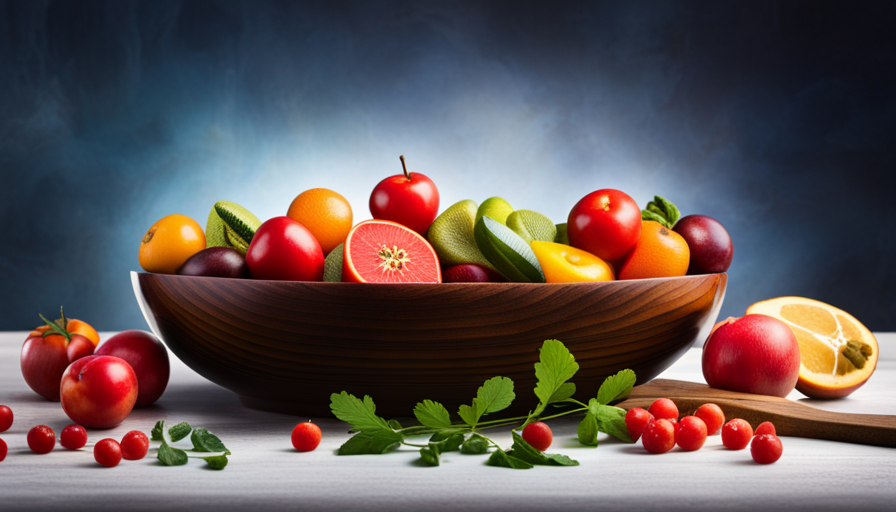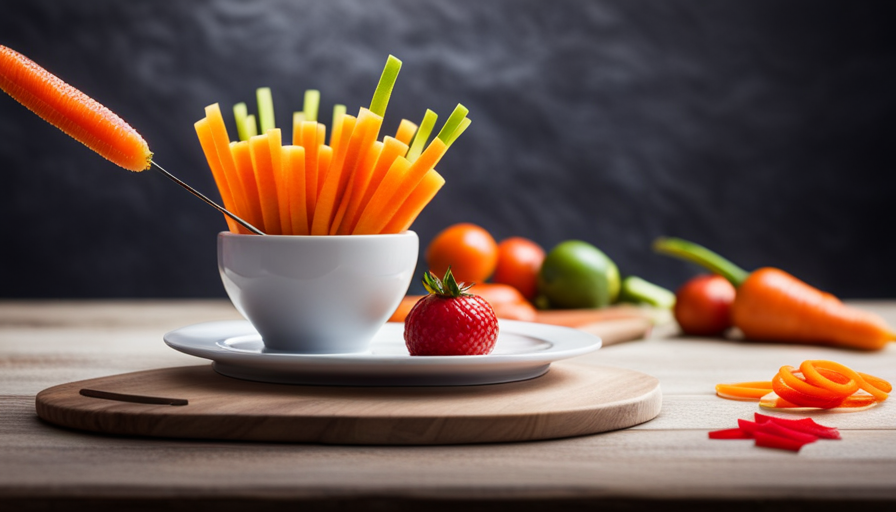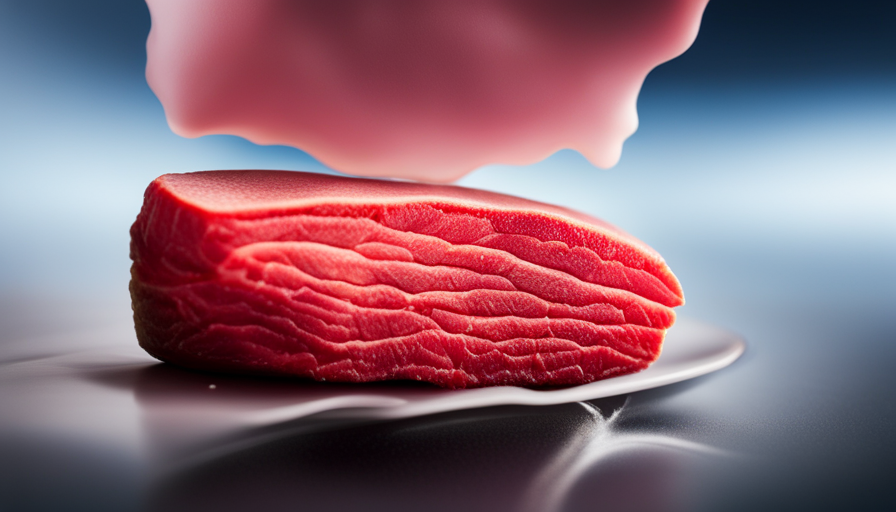Are you following a raw food diet and concerned about getting enough calcium? No need to worry, it’s easy to meet your calcium needs while enjoying the benefits of a raw food lifestyle. Calcium is crucial for strong bones and teeth, as well as for muscle function and nerve communication.
As a nutritionist, I understand the importance of incorporating calcium-rich foods into your raw food diet. By focusing on plant-based sources such as leafy greens, nuts, and seeds, you can ensure an adequate intake of this vital nutrient. Additionally, calcium-fortified foods and supplements can help boost your calcium levels. Remember to also consider vitamin D, which aids in calcium absorption.
With a little knowledge and creativity, you can successfully obtain the calcium your body needs while thriving on a raw food diet. Let’s explore some practical tips and delicious recipes to make it happen.
Key Takeaways
- Raw food diet can provide sufficient calcium through plant-based sources like leafy greens, nuts, and seeds.
- Incorporating calcium-rich raw foods such as kale, spinach, broccoli, almonds, chia seeds, sesame seeds, tofu, and seaweed can help meet calcium needs.
- Pairing calcium-rich superfoods with vitamin D-rich foods or supplements can enhance calcium absorption.
- Monitoring calcium levels, considering calcium supplements, and consulting healthcare professionals can help ensure optimal calcium intake on a raw food diet.
Importance of Calcium in a Raw Food Diet
You might be wondering how to ensure you’re getting enough calcium on a raw food diet, but fear not, because there are plenty of delicious and nutrient-rich plant-based sources that’ll keep your bones strong and your body thriving. Calcium is important for bone health as it helps maintain the structure and strength of your bones. The recommended daily intake of calcium for adults is around 1000 mg, and this can easily be achieved on a raw food diet.
There are several raw food sources that are rich in calcium. Leafy greens like kale, spinach, and collard greens are excellent options. Other calcium-rich raw foods include broccoli, almonds, chia seeds, sesame seeds, and tofu. Incorporating these foods into your daily meals will help ensure you meet your calcium needs.
To make it even easier, here are some practical tips and recipe ideas to help you incorporate calcium-rich raw foods into your diet. Add a handful of spinach or kale to your morning smoothie, sprinkle chia or sesame seeds over your salads, or make a delicious raw broccoli and almond salad. You can also experiment with making your own raw almond milk or use tofu in raw food recipes.
By incorporating these calcium-rich raw foods into your diet, you can rest assured that you’re meeting your body’s calcium needs and promoting strong and healthy bones.
Plant-Based Sources of Calcium
Contrary to popular belief, there are plenty of plant-based options available that can effectively meet your calcium needs on a raw diet. As a nutritionist, I understand the importance of calcium in a raw food diet, and I can provide you with evidence-based recommendations on how to incorporate calcium-rich foods into your meals.
Here are three plant-based calcium sources that you can easily include in your raw food diet:
-
Leafy greens: Foods like kale, spinach, and collard greens are excellent sources of calcium. These greens can be enjoyed in salads, smoothies, or even in raw wraps for a nutrient-packed meal.
-
Sesame seeds: These tiny seeds are a powerhouse of calcium. Sprinkle them on top of your salads, blend them into dressings or dips, or include them in your raw energy balls for a tasty and calcium-rich snack.
-
Calcium-rich fruits: While fruits are generally not high in calcium, certain options are worth considering. Oranges, figs, and blackberries contain some calcium and can be enjoyed as part of a balanced raw food diet.
By incorporating these plant-based calcium sources into your raw food diet, you can ensure that you’re meeting your calcium needs. Remember to vary your food choices and consult with a registered dietitian to make sure you’re getting all the necessary nutrients on a raw food diet.
Incorporating Leafy Greens into Your Diet
When it comes to incorporating leafy greens into your meals, there are plenty of delicious and creative ways to enjoy these nutrient-rich powerhouses. As a nutritionist or registered dietitian, I’ve got a deep understanding of the nutritional requirements of individuals on a raw food diet and extensive knowledge about the sources of calcium in raw foods and how to incorporate them into a balanced diet.
Leafy greens, such as kale, spinach, and collard greens, are excellent sources of calcium for those on a raw food diet. One creative way to incorporate these greens into your meals is by making a green smoothie. Simply blend a handful of leafy greens with fruits like bananas or berries for a refreshing and calcium-packed drink.
Another way to enjoy leafy greens is by making a raw salad. Mix different varieties of greens like romaine lettuce, arugula, and Swiss chard, and toss them with a homemade dressing made from avocado, lemon juice, and herbs. Add in some calcium-rich toppings like sesame seeds or almonds for an extra boost.
Incorporating leafy greens into your diet doesn’t have to be boring or bland. Get creative by making collard green wraps filled with raw vegetables and hummus, or try making a raw pesto using basil and spinach. These innovative ways to enjoy leafy greens won’t only provide you with the calcium you need on a raw food diet but also keep your taste buds satisfied.
Nuts and Seeds as Calcium-Rich Options
Incorporating nuts and seeds into your meals can provide a delicious and nutrient-rich way to boost your calcium intake on a raw food diet. These plant-based foods aren’t just packed with essential nutrients, but they also contain high levels of calcium that can contribute to your overall bone health. Here are three nuts and seeds that are excellent sources of calcium and can easily be incorporated into your raw food meals:
-
Almonds: Almonds are a great choice for increasing your calcium intake. Just one ounce of almonds provides about 76 milligrams of calcium, which’s equivalent to about 7% of your daily recommended intake. You can enjoy almonds as a snack, sprinkle them on top of salads, or blend them into a creamy almond milk.
-
Sesame seeds: These tiny seeds are a powerhouse of calcium. One tablespoon of sesame seeds contains about 88 milligrams of calcium, which’s around 9% of your daily recommended intake. You can sprinkle sesame seeds on top of raw food dishes, include them in homemade energy balls, or use tahini (sesame seed paste) in dressings or dips.
-
Chia seeds: Chia seeds aren’t just a great source of omega-3 fatty acids and fiber but also calcium. Two tablespoons of chia seeds provide about 177 milligrams of calcium, which’s approximately 18% of your daily recommended intake. You can add chia seeds to smoothies, make chia seed puddings, or use them as a thickening agent in raw desserts.
Remember, to maximize calcium absorption, it’s important to soak or sprout nuts and seeds before consuming them. This process helps to neutralize phytic acid, which can inhibit calcium absorption. So go ahead and incorporate these calcium-rich nuts and seeds into your raw food meals to support your overall health and well-being.
Calcium-Fortified Foods for Raw Food Dieters
Boost your calcium intake on a raw food diet with the help of calcium-fortified options that can easily be incorporated into your meals. Calcium-fortified juices are a convenient and tasty way to increase your calcium intake. Look for brands that specifically mention calcium fortification on the label. These juices are usually made from fruits or vegetables and are fortified with calcium to provide an extra boost of this essential mineral. They can be enjoyed on their own or used as a base for smoothies or raw food recipes.
Another calcium-rich option for raw food dieters is seaweed. Seaweed is a natural source of calcium and can be easily incorporated into various dishes. It can be used as a wrap for raw sushi rolls, added to salads, or blended into soups. Wakame, kelp, and dulse are some types of seaweed that are particularly high in calcium.
To help you visualize the calcium content of these options, here’s a table showing the approximate calcium content per 100 grams:
| Food | Calcium Content (mg) |
|---|---|
| Calcium-fortified juices | 150-200 |
| Seaweed | 130-150 |
Incorporating calcium-fortified juices and calcium-rich seaweed into your raw food diet can help ensure you meet your daily calcium needs. Remember to consult with a nutritionist or registered dietitian for personalized advice and to ensure you are getting all the nutrients you need on a raw food diet.
Superfoods for Calcium Absorption
Maximize your calcium absorption with these powerful superfoods. When following a raw food diet, it’s important to ensure you’re getting enough calcium for optimal bone health. Luckily, there are several superfoods that are not only rich in calcium but also promote its absorption in the body.
First, let’s talk about leafy greens. Kale, spinach, and collard greens are excellent sources of calcium. They’re also packed with other essential nutrients like vitamin K, which is important for bone health.
Another superfood for calcium absorption is chia seeds. These tiny seeds are a powerhouse of nutrients, including calcium. They can be easily incorporated into your diet by adding them to smoothies, salads, or homemade energy bars.
In addition, don’t forget about calcium-rich fruits. Oranges, figs, and blackberries are all great options. They not only provide calcium but also offer a variety of antioxidants that support overall health.
To maximize the absorption of calcium from these superfoods, it’s important to pair them with vitamin D-rich foods, as vitamin D helps the body absorb calcium. Consider including mushrooms, fortified plant-based milk, or spending some time in the sun to boost your vitamin D levels.
By including these superfoods in your raw food diet, you can ensure you’re meeting your calcium needs while enjoying a variety of delicious and nutritious foods.
Ensuring Vitamin D Intake for Calcium Absorption
To ensure optimal calcium absorption on a raw food diet, it’s essential to consider the role of vitamin D. Vitamin D plays a crucial role in calcium metabolism, as it helps the body absorb and utilize calcium effectively.
While raw foods can provide a good amount of calcium, it’s important to ensure sufficient vitamin D intake to support its absorption.
One practical way to ensure vitamin D intake is through natural sunlight. Spending time outdoors, especially during peak sunlight hours, allows the body to produce vitamin D naturally. Aim for at least 15 to 30 minutes of sun exposure on your face, arms, and legs a few times a week. However, it’s important to practice sun safety and avoid excessive exposure that may lead to sunburn.
If natural sunlight is limited or not accessible, vitamin D supplements can be a reliable option. Look for a high-quality supplement that provides sufficient vitamin D3, the active form of the vitamin. Consult with a healthcare professional to determine the appropriate dosage for your specific needs.
By incorporating natural sunlight or vitamin D supplements into your raw food diet, you can ensure adequate vitamin D levels, promoting optimal calcium absorption and supporting overall bone health. Remember to prioritize your health and consult with a healthcare professional for personalized advice.
Balancing Calcium and Phosphorus in a Raw Food Diet
Maintaining a harmonious balance between calcium and phosphorus can be quite the juggling act on a raw food eating plan. As a nutritionist or registered dietitian, I understand the importance of this delicate balance and the potential risks of low calcium intake.
When it comes to obtaining calcium on a raw food diet, it’s essential to choose calcium-rich foods that also have a favorable calcium-to-phosphorus ratio.
Some raw foods that are excellent sources of calcium include leafy greens like kale, collard greens, and spinach. These greens not only provide calcium but also have a low phosphorus content, making them ideal for maintaining the balance. Other options include sesame seeds, almonds, and chia seeds, which can be easily incorporated into smoothies, salads, or homemade raw energy bars.
To ensure you’re getting enough calcium, try incorporating calcium-rich raw foods into your meals and snacks throughout the day. For example, you can start your day with a green smoothie made with kale, almond milk, and chia seeds. For lunch, enjoy a salad with spinach, sesame seeds, and a lemon-tahini dressing. Snack on almonds or make a calcium-rich raw dessert using ground sesame seeds.
By focusing on a variety of calcium-rich raw foods with a favorable calcium-to-phosphorus ratio, you can maintain adequate calcium levels and support overall bone health on a raw food diet. Remember to consult with a healthcare professional to assess your specific nutritional needs.
Calcium Supplements for Raw Food Dieters
Make sure you’re taking advantage of the benefits of calcium supplements to support your bone health and keep your body strong on a raw food eating plan. Calcium is an essential mineral that plays a crucial role in maintaining strong bones and teeth, as well as supporting proper muscle and nerve function. While raw food diets can provide a wealth of nutrients, it can sometimes be challenging to get enough calcium solely from plant-based sources. That’s where calcium supplements come in handy.
To help you understand the importance of calcium supplements and how they can benefit your raw food diet, let’s take a look at the following table:
| Calcium Supplements | Benefits |
|---|---|
| Calcium carbonate | Easily absorbed by the body and highly bioavailable. |
| Calcium citrate | Ideal for individuals with low stomach acid or digestive issues. |
| Calcium lactate | A good option for those seeking a dairy-free calcium source. |
| Calcium gluconate | Suitable for individuals with sensitive stomachs. |
As a nutritionist, I recommend choosing a calcium supplement that suits your individual needs and preferences. However, it’s important to remember that calcium supplements should complement a diet rich in natural sources of calcium, such as leafy greens, nuts and seeds, and fortified plant-based milk alternatives. By incorporating a combination of calcium-rich raw foods and supplements into your daily meals, you can ensure that you’re meeting your calcium requirements and supporting your overall bone health on a raw food diet.
Monitoring Calcium Levels and Consulting a Healthcare Professional
It’s crucial to keep an eye on your calcium levels and seek guidance from a healthcare professional. A nutritionist or registered dietitian would demonstrate a deep understanding of the nutritional requirements of individuals on a raw food diet. They would have extensive knowledge about the sources of calcium in raw foods and how to incorporate them into a balanced diet.
Professionals in the field of nutrition adhere to evidence-based practices. When writing about getting calcium on a raw food diet, a nutritionist or registered dietitian would base their recommendations on scientific research and studies. They would provide reliable and accurate information that’s supported by credible sources.
Nutritionists and registered dietitians aim to provide practical advice that can be easily implemented by their clients. When discussing how to obtain calcium on a raw food diet, they would likely include practical tips, suggestions, and recipe ideas to ensure individuals can easily incorporate calcium-rich raw foods into their daily meals.
To monitor calcium levels, healthcare professionals may suggest regular blood tests to assess your calcium status. They can also provide guidance on how to interpret the results and make appropriate adjustments to your diet if needed. Consulting a healthcare professional is essential to ensure that you’re meeting your calcium needs and maintaining optimal health on a raw food diet.
Frequently Asked Questions
Can I get enough calcium on a raw food diet without consuming dairy products?
Yes, you can definitely get enough calcium on a raw food diet without consuming dairy products. There are many calcium-rich raw food alternatives available. Some excellent sources include leafy green vegetables like kale and broccoli, nuts and seeds like almonds and chia seeds, and certain fruits like oranges and figs. By incorporating these calcium sources into your daily meals, you can easily meet your calcium needs while enjoying a raw food diet.
Is it possible to consume too much calcium on a raw food diet?
Yes, it’s possible to consume too much calcium on a raw food diet. While calcium is essential for bone health and other bodily functions, excessive intake can lead to health issues like kidney stones and impaired absorption of other minerals.
However, by focusing on calcium-rich plant-based foods and considering calcium absorption factors such as vitamin D and magnesium, you can ensure a balanced intake. A knowledgeable nutritionist or registered dietitian can guide you on the right amounts and sources of calcium on a raw food diet.
How can I ensure that I am getting enough vitamin D for proper calcium absorption?
To ensure that I’m getting enough vitamin D for proper calcium absorption on a raw food diet, sunlight exposure is crucial. Sunlight triggers the synthesis of vitamin D in my body, which is essential for calcium absorption.
Additionally, there are plant-based sources of vitamin D that can help me meet my needs. Foods like mushrooms, fortified plant-based milks, and tofu can provide me with this important nutrient.
Incorporating these foods into my daily meals will help support my calcium absorption on a raw food diet.
Are there any potential side effects or risks associated with calcium supplementation on a raw food diet?
On a raw food diet, potential risks associated with calcium supplementation should be carefully considered. While calcium is essential for bone health, excessive supplementation can lead to side effects such as constipation, kidney stones, and impaired absorption of other minerals.
It’s important to consult with a nutritionist or registered dietitian who can provide evidence-based recommendations tailored to your specific needs. They can guide you on incorporating calcium-rich raw foods into your diet to ensure a balanced intake without the need for supplementation.
How frequently should I monitor my calcium levels and when should I consult a healthcare professional?
To ensure your calcium levels are within a healthy range, it’s important to monitor them regularly. The frequency of monitoring will depend on your individual circumstances, but as a general guideline, it’s recommended to have your calcium levels checked at least once a year.
However, if you have specific health concerns or you’re at a higher risk for calcium deficiency, more frequent monitoring may be necessary. It’s always best to consult a healthcare professional who can provide guidance and personalized recommendations based on your unique needs.
Is it possible to get enough calcium on a raw food diet?
Yes, getting enough calcium on a raw diet is possible. Raw food options like almonds, leafy greens, and broccoli are excellent sources of calcium. Additionally, incorporating fortified foods and non-dairy milk alternatives can help ensure that you are getting nutrients raw diet, including calcium.
Conclusion
In conclusion, to ensure optimal calcium intake on a raw food diet, it’s important to incorporate a variety of plant-based sources such as leafy greens, nuts, and seeds.
Additionally, consuming calcium-fortified foods and ensuring adequate vitamin D intake for absorption is crucial. Balancing calcium and phosphorus levels and considering calcium supplements may also be beneficial.
Remember to monitor calcium levels and consult a healthcare professional for personalized advice.
By following these practical tips, you can easily meet your calcium needs while enjoying the benefits of a raw food diet.










